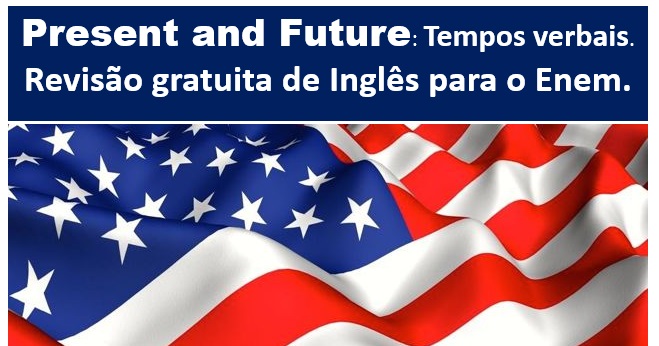Preocupação com os Tempos Verbais para as questões de Inglês no Enem? Então revise sobre o Verbal Tense nesta aula que preparamos para que você gabarite na prova. Confira abaixo.
Tempos Vebais (present and future) – Text – É hora de revisar. Vamos começar com um exercício bem simples. Bora lá!

1. De acordo com a charge acima, escolha a alternativa correta: a) Snoopy tenta ensinar Lucy a saltar; b) Linus dá a entender que sua irmã Lucy é mandona; c) Linus ensina Snoopy como lidar com Lucy; d) Snoopy passa a ser eternamente o cachorro de Lucy; d) Lucy quer comprar um cachorro para seu irmão Linus.
Vamos em frente que agora aperta mais um pouco. Leia com calma para responder os exercícios logo abaixo: “When I look in the mirror1 – I see myself. when I look at myself – I see my soul2. when I look at my soul – I see the sky. When I look at the sky – I see myself.”
Myself (My*self”) (?), pron.; pl. Ourselves (¿). I or me in person; — used for emphasis, my own self or person; as I myself will do it; I have done it myself; — used also instead of me, as the object of the first person of a reflexive verb, without emphasis; as, I will defend myself. (– reflexive pron. –)
Dica 1 – Relembre tudo sobre os Personal Pronouns nesta aula de revisão para a prova de Inglês Enem. Estude com a gente para o Exame Nacional do Ensino Médio!
Vocabulary
1. Mirror – Espelho
2. soul – Alma
Questions on the text
1. De acordo com o texto, o autor do poema acima:
a) Prefere não olhar para o espelho.
b) Vê sua própria alma através das estrelas.
c) Acredita que pode ver também sua própria alma quando se vê no espelho.
d) Enxerga o céu através do espelho de seu quarto.
e) Acredita que sua própria alma reflete o espelho.
a) Quando me canso, canso minha alma.
b) Sempre que me olho, esqueço-me de minha alma.
c) Ao olhar minha alma, vejo meu filho.
d) Quando olho para mim mesmo, vejo minha alma.
e) Minha alma é vista por mim mesmo.

Simple Future
Sally will bring her kids tomorrow.
Nobody will notice that she has lost 10 pounds.
Dica 2 – Lembra tudo sobre o plural dos substantivos? Revise com esta aula sobre Plural of Nouns e garanta a sua nota na prova de Inglês Enem!
Formação
|
WILL (para todas Ou SHALL (para I e |
||
|
+ VP no infinitivo sem to |
||
Obs.: WILL e SHALL têm a contração ’LL
Uso:
O simple future é usado para descrever que o que vai ocorrer no futuro.
We will (shall) travel to Rome next year.
The Brightons will come to visit us in July.
Going to
I bought the tickets yesterday,
so I’m going to see the show tomorrow night.
Formação:
to be + going to + infinitivo do verbo principal.
Michael is going to take his car to the garage …
Uso:
Usamos o going to (immediate future) para descrever uma ação em um futuro próximo, que planejamos fazer ou que está prestes a acontecer.
We are going to meet Joe next Friday.
We are going to play soccer tonight.
The clouds are so gray; I believe it is going to rain.
Veja uma aula sobre simple future para complementar seus estudos!
Simple Present
Michael always comes home after seven.
The World Cup takes place every four year.
Herbs from the Amazon cure many types of disease
Formação:
O Simple Present é formado a partir do verbo no infinitivo, sem o “to”.
Ex: to dance
Sally and Peter usually dance the whole party.
Nota: Os verbos na terceira pessoa do singular (HE, SHE e IT) sofrem o acréscimo de “S”.
Tom never brings his book to school.
Atenção:
• Os verbos terminados em S, SH, CH, X, O e Z sofrem o acréscimo de “ES”.
to do – she does
to wash – she washes
- • Em verbos terminados em y precedidos de consoante, corta-se o y e acrescenta-se ies:
to cry – Paul cries
to hurry – she hurries
Dica 3 – Revise tudo para Exame Nacional do Ensino Médio em mais esta aula sobre os Possessive Pronouns para a prova de Inglês Enem.
Usos:
1. O Simple Present é usado em ações que ocorrem habitualmente ou com certa frequência:
The Smiths often play cards together.
My uncle Nelson travels to New York every year.
2. O Simple Present também expressa ações de verdade universal:
Nurses look after their patients.
The earth goes around the sun.
Present Continuous
Where’s Donna? She is talking on the phone.
Watch out! The enemies are coming.
Formação:
O Present Continuous é formado com o verbo auxiliar “TO BE” no presente e o verbo principal na forma de gerúndio (ing).
Atenção:
Regras para o uso do ING:
1. Em verbos terminados em E:
arrive – arriving
2. Verbos oxítonos terminados em Consoante-Vogal-Consoante:
control – controlling
admit – admitting
3. Verbos terminados em IE:
lie – lying
die – dying
Usos:
Usamos o PRESENT CONTINUOUS para indicar uma ação que ocorre no EXATO MOMENTO da fala.
Michael is driving his car now.
The teachers are reading their books this morning.
Nota: O PRESENT CONTINUOUS é usado também após a VOZ IMPERATIVA:
Look out the window! It is raning.
Atenção:
Os seguintes verbos não são normalmente usados em tempos contínuos:
like hate love want need prefer know realize suppose mean seem understand believe contain remember belong consist
I remember the story now.
Exercícios para você não esquecer mais!
Question 1
(UFSC) Select the propositions which indicate future.
a) Paul and Mary are going to travel to Africa in July.
b) The children will not be hungry anymore.
c) David is going to study in a good school.
d) Gregorie is working in Africa now.
e) David will be eleven years old next year.
f) David and his family need help.
Question 2
(VUNESP) Assinale a alternativa que preenche corretamente cada lacuna da frase apresentada.
I __________ to the radio every day, but I __________ listening to it now.
a) listen … am not
b) listened … had
c) listening … was not
d) was listening … not
e) not listen … was
Question 3
My uncle Nelson _______ to New York every year.
Choose the alternative that best completes the sentence above:
a) traveled
b) travelling
c) is travelling
d) to travel
e) travels
Question 4
(UNINOVE) Birds ____ to the South.
a) flies
b) fly
c) is flying
d) flying
e) flyed
Question 5
(ACAFE) Be careful! The old man ____________
every word that you are saying.
a) has understanding
b) understanding
c) understands
d) is understanding
Material Complementar
A portrait of myself.
Responda o questionário abaixo revelando as preferências, gostos, etc, para que possa conhecer “yourself” melhor:

– I like sport practicing.
YES ( ) NO ( )
– I have a boy-friend/girlfriend.
YES ( ) NO ( )
– I study more than two hours day.
YES ( ) NO ( )
– I read, at least*, five books a year.
YES ( ) NO ( )
– I hate to do activities by myself.
YES ( ) NO ( )
– I like to talk to people.
YES ( ) NO ( )
– I like outdoor activities.
YES ( ) NO ( )
– I am an altruist person.
YES ( ) NO ( )
* at least – no mínimo
Answers: If most (or all) of your answers are “YES”, then you are probably an extrovert person and like to be with friends, but if you answered “NO” for most questions, then perhaps(1) you are a little shy(2) or prefer to spend some time(3) with yourself.
No matter what(4) you answered to the questions above, you should(5) always say “YES” for the topic “I read, at least, five books a year.”, ok?
(1) perhaps – talvez
(2) shy – tímido
(3) to spend some time – passer algum tempo
(4) No matter what – Não importa o que
(5) should – deveria
Você consegue resolver estes exercícios? Então resolva e coloque um comentário no post, logo abaixo, explicando o seu raciocínio e apontando a alternativa correta para cada questão. Quem compartilha a resolução de um exercício ganha em dobro: ensina e aprende ao mesmo tempo. Ensinar é uma das melhores formas de aprender!
